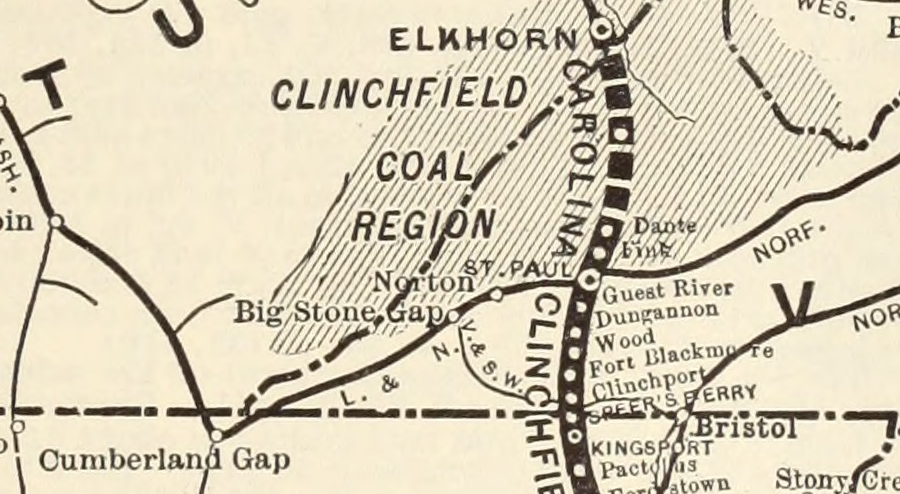
the Carolina, Clinchfield and Ohio Railway northern end was at Elkhorn City, Kentucky
Source: The Commercial and Financial Chronicle (1911)

the Carolina, Clinchfield and Ohio Railway northern end was at Elkhorn City, Kentucky
Source: The Commercial and Financial Chronicle (1911)
The Carolina, Clinchfield and Ohio Railway (the "Clinchfield") was built to carry coal from Southwest Virginia to customers in the southeastern United States and the Ohio River Valley. The 277-mile long railroad ultimately stretched from Elkhorn City, Kentucky to Spartanburg, South Carolina.
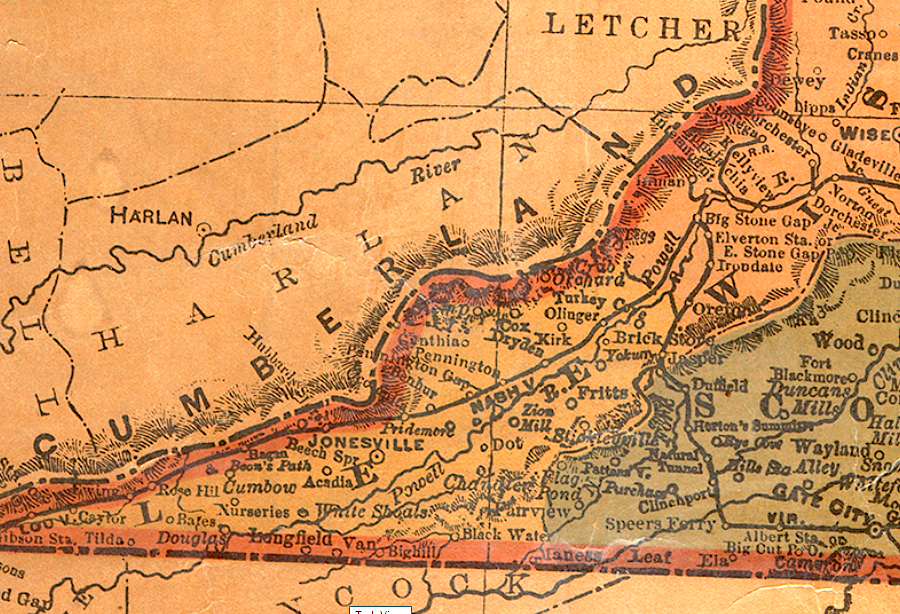
Southwest Virginia railroads in 1902, before the Clinchfield
Source: Library of Virginia, Rand-McNally new railroad and county map: Virginia and West Virginia (1902)
What became the "Clinchfield" was spurred by demand from South Carolina merchants. In 1830 Charleston, South Carolina investors financed the first long railroad in North America designed for wood-burning locomotives, from Charleston to the Fall Line on the Savannah River. The business and political leaders in Charleston continued to expand their transportation network in order to draw trade from inland areas (the "hinterland") to the port.
There were multiple proposals to build a road from South Carolina north to the Ohio River Valley and the Great Lakes. Representatives from multiple states met in an 1831 convention at Estillville, Virginia (now Gate City), and proposed a road with a crushed stone surface linking Charleston to Pikeville, Kentucky, which at the time was the head of navigation on the Levisa Fork of the Big Sandy River. From Pikeville, ships could carry freight and passengers on the navigable stretch of the Big Sandy River further north to the Ohio River.

Moccassin Gap in Scott County was an obvious route for a railroad across Clinch Mountain
Source: Col. Long's report to the Estillville Convention (1831)
The legislature in South Carolina chartered the Louisville, Cincinnati and Charleston Railroad in 1835. That first attempt to build a railroad connnecting the Ohio River Valley with an Atlantic Ocean port would have bypassed Virginia. Track was planned from Charleston to Asheville, North Carolina, then west to Knoxville and north through Kentucky to Cincinnati. The 1837 financial recession ended that initiative.
A second attempt was made in the 1850's. The Blue Ridge Railroad started construction from Aiken, South Carolina west into Georgia, then turning north towards Knoxville, Tennessee. It failed after the economic recession known as the Panic of 1857 and then the Civil War, leaving the expensive and unfinished Stumphouse Mountain Tunnel cut into the Blue Ridge.1
In 1886, investors organized the Charleston, Cincinnati and Chicago Railroad (the "3-C" line). It planned to cross the southeastern edge of Virginia to access coal fields and iron ore there.
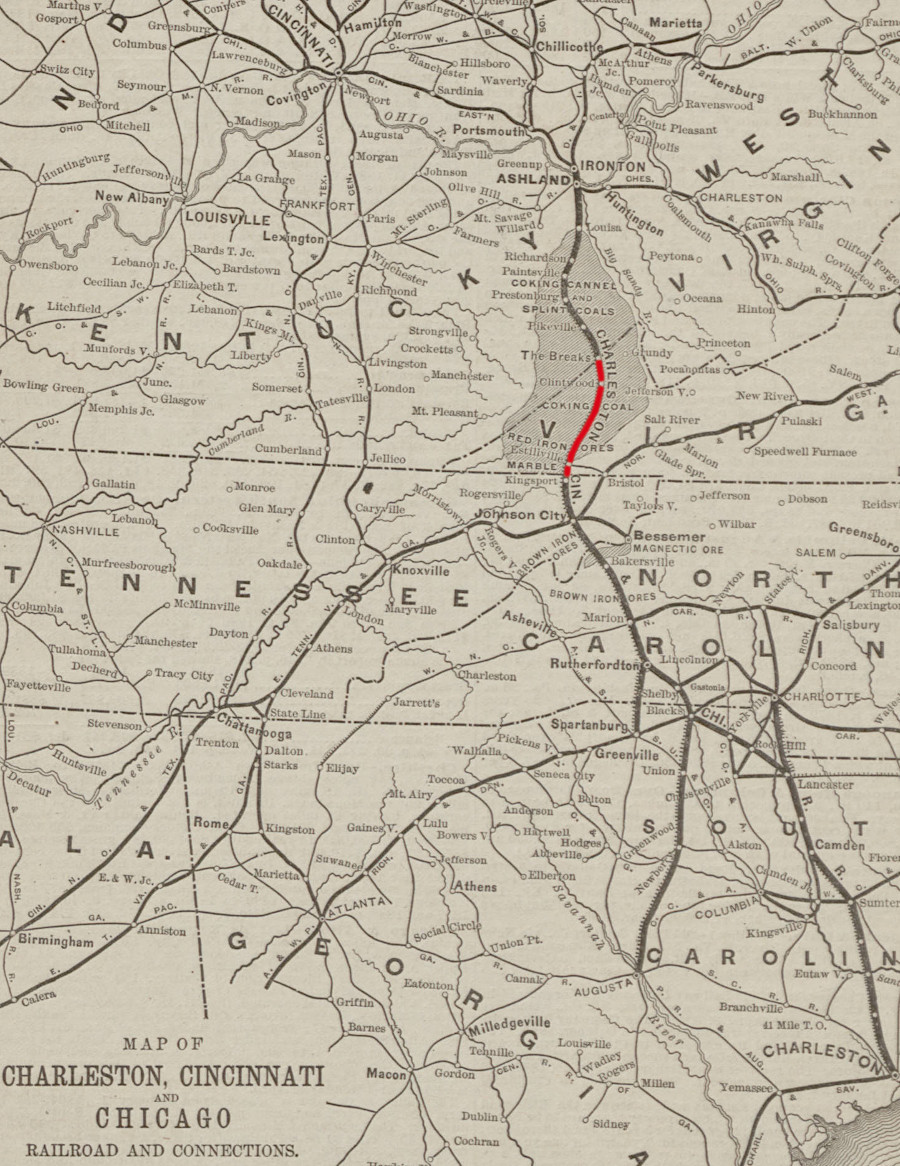
the Charleston, Cincinnati and Chicago Railroad was planned to cross the Clinch River coal fields between Kingsport, Tennessee and Elkhorn City, Kentucky
Source: University of South Carolina Libraries, Map of Charleston, Cincinnati and Chicago Railroad and connections
Construction began at multiple places. By 1889 the Charleston, Cincinnati and Chicago Railroad stretched from Camden, South Carolina north to the base of the Blue Ridge at Marion, North Carolina. Track also was laid from Johnson City south to the Nolichucky River. That left a gap at the Blue Ridge between Marion and the Nolichucky River, where construction was delayed due to the high cost of cutting through the mountains.
A railbed was built at two places north of Johnson City. One railroad grade, without ties or rails, was completed to Turkey Foot (Dante), Virginia. Further north, a graded bed was prepared between Whitehouse and Ashland in Kentucky. That bed ran along the edge of the Levisa Fork and the Big Sandy River. That left a second gap through the roughest topography of the Appalachians, between Turkey Foot (Dante) in Virginia and Whitehouse in Kentucky.
The Charleston, Cincinnati and Chicago Railroad never closed the gaps, and never laid track on the graded beds. Failure of the Barings Bank in England in the 1893 recession dried up the loans needed to fund further construction, and the railroad was sold in foreclosure. New buyers reorganized it as the Ohio River & Charleston Railway in 1896.
The Ohio River & Charleston Railway planned to build through the Blue Ridge in North Carolina and connect the operating railroad in Tennessee to the Atlantic Ocean at Wilmington, North Carolina. The track was extended in Tennessee towards a mountain crossing, but the investment in the extension generated little revenue. To raise funds, the Ohio River & Charleston Railway sold the unfinished sections north of Johnson City.
The most-northern graded bed, stretching from Whitehorse to Ashland in Kentucky, was sold to the Chesapeake and Ohio Railway. The Ohio River & Charleston Railway sold the graded bed between Johnson City and Turkey Foot (Dante) to the ambitiously-named Lick Creek and Lake Erie Railroad.2
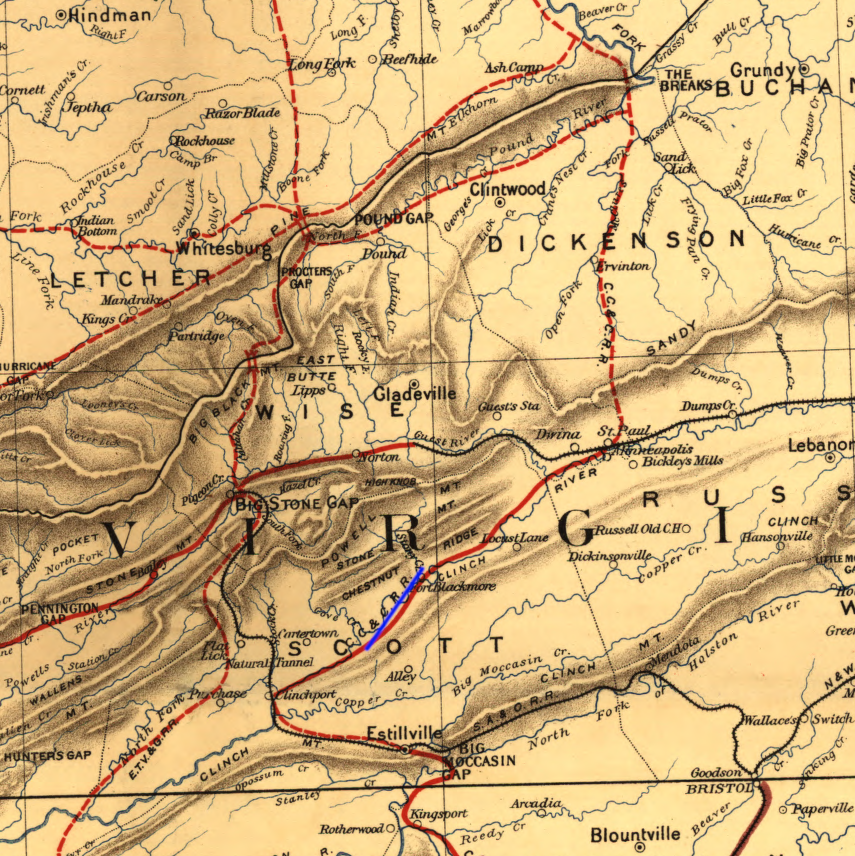
in 1891, the Charleston, Cincinnati and Chicago Railroad planned to tunnel through Sandy Ridge north of St. Paul to reach Elkhorn City
Source: Library of Congress, Preliminary map of Kentucky 1891
Stilson Hutchins had organized the Lick Creek and Lake Erie Railroad. In 1901 he purchased the coal rights around a community known as Turkey Foot, because of the shape of the three forks of Lick Creek. Hutchins renamed the place after William Joseph Dante, a business associate.
A railroad connection from Turkey Foot/Dante to potential customers was essential to make the coal in the nearby mountains worth mining. The charter of the Lick Creek and Lake Erie Railroad, issued by the General Assembly in 1902, authorized construction of a railroad linking Dante to the Norfolk and Western Railway at St. Paul, and for 20 miles "in a northwardly direction" from Lick Creek into the coal fields.
Demand for more rail infrastructure increased when the Clinchfield Coal Company chose Dante as the site for its headquarters in 1906.3
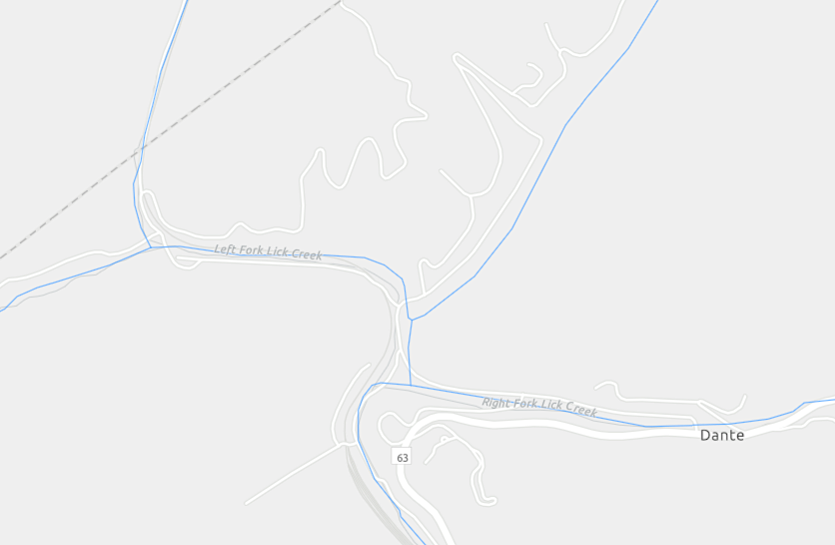
Dante was previously called Turkey Foot, based on the shape of three forks of Lick Creek which converged there
Source: ESRI, ArcGIS Online
The Lick Creek and Lake Erie Railroad laid rails on seven miles of the graded trackbed along Lick Creek between St. Paul and Dante, linking to the Norfolk and Western . However, there was little potential for owners of the undercapitalized Lick Creek and Lake Erie Railroad to build south to Johnson City, or especially north through the rugged terrain of the Appalachian Plateau to Lake Erie.
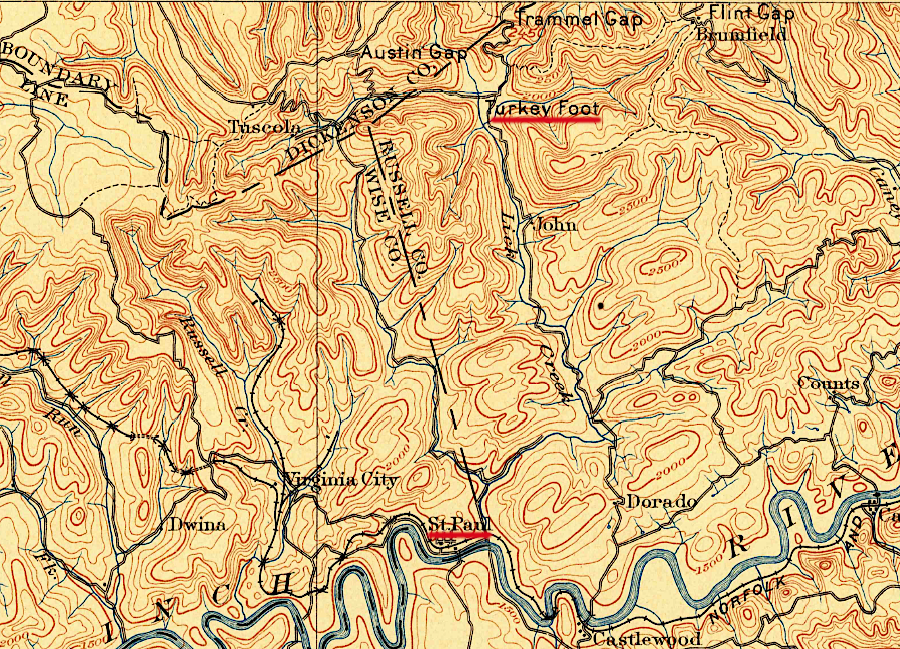
the Lick Creek and Lake Erie Railroad operated between Turkey Foot (Dante) and St. Paul
Source: US Geological Survey (USGS), Bristol 1"125,000 topographic quadrangle (1902)
Grading a railroad line past Dante, at the headwaters of Lick Creek, would require digging an expensive tunnel. Sandy Ridge, at the headwaters of Lick Creek, was the watershed divide separating the Clinch and Big Sandy watersheds at the Allegheny Front. A railroad at Turkey Foot, Virginia would have to tunnel through Sandy Ridge to go 20 miles "in a northwardly direction" from Lick Creek.
Since the Chesapeake and Ohio Railway had purchased the rights of the Ohio River & Charleston Railway to build through Kentucky, the closest the Lick Creek and Lake Erie Railroad could get to Lake Erie (if authorized by the General Assembly) was Praise, Kentucky. That community is now Elkhorn City, on the Russell Fork of the Big Sandy River just west of Breaks Interstate Park. Construction from Dante to Kentucky required the railroad to find major financing.
George L. Carter had the business skills and financial connections to construct a railroad "in a northwardly direction" from Dante across the Eastern Continental Divide into Kentucky. Carter started by getting South Carolina to charter the South and Western Railway in 1902, with a vague authorization to go between any point on the Atlantic Ocean to any point on the Great Lakes.
George L. Carter purchased the Lick Creek and Lake Erie Railroad in 1902. He planned to transport coal from Southwest Virginia to Atlantic Ocean ports, including Wilmington, Charleston, Savannah, and Jacksonville. He also planned to open a steamship line to ship coal to destinations in the Caribbean, including Cuba.
In 1905, Carter recruited a Wall Street investment company to finance his plans and construct the required tunnels. In 1908, the railroad name was changed to Carolina, Clinchfield and Ohio Railway, and service began across the Blue Ridge between Marion and Johnston City. Service south from Dante to Spartanburg, South Carolina began in 1909.4
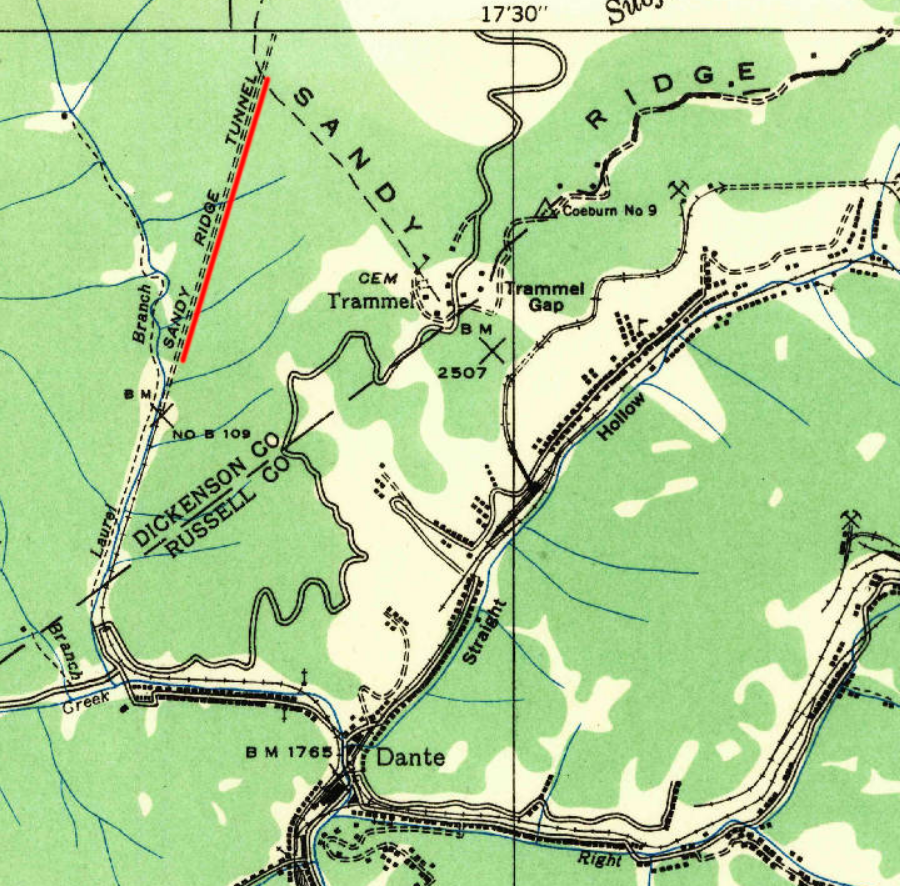
George L. Carter found financial backers and extended the Carolina, Clinchfield and Ohio Railway north from Dante, digging an expensive tunnel through Sandy Ridge
Source: US Geological Survey (USGS), St. Paul, VA 1:24,000 topographic quadrangle (1935)
Though George Carter acquired many assets once part of the planned "3-C" line, he listened to the recommendations of his General Manager and Chief Engineer, M. J. Caples. Caples recommended altering the route and investing significantly more in constructing a railroad on a different alignment with lower grades and gentler curves to haul coal.
The tradeoff was the construction of multiple tunnels and bridges, which were more expensive than building along the edges of the watercourses. The higher initial construction costs would be recovered by lower operating costs. When completed, the Carolina, Clinchfield and Ohio Railway had a maximum 1.2% grade and a maximum 8° curve south of Dante.
For the Dante-Elkhorn City extension, 42 alternative routes were examined. One included building 4% grade switchbacks over Sandy Ridge rather than digging a tunnel. The final choice was the most expensive, but also the shortest. Tunneling through "The Towers" rather than following the curves of the Russell Fork reduced track construction by two miles, but required increasing the grade from 1% to 1.5%.5
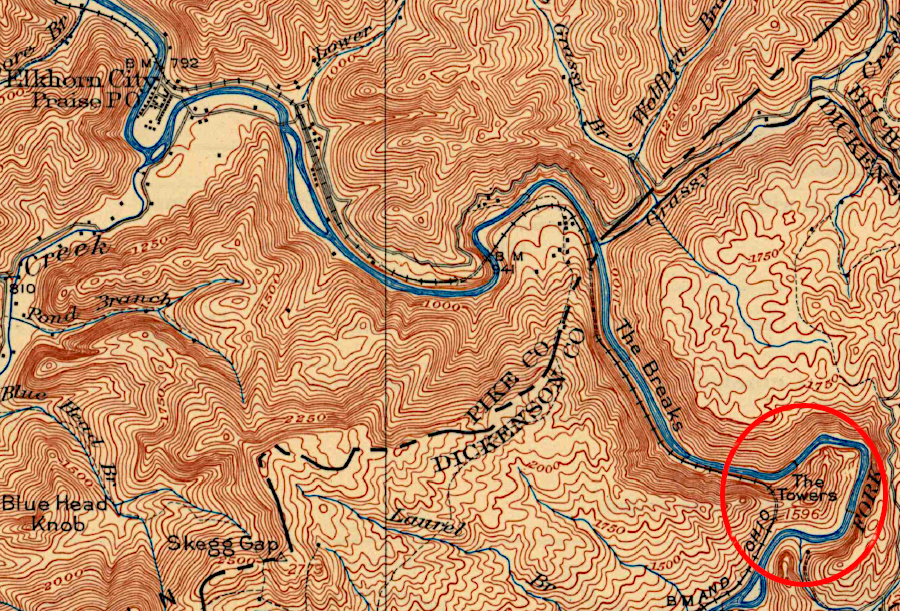
tunneling through The Towers increased the grade from 1% to 1.5%, but reduced track mileage by two miles
Source: US Geological Survey (USGS), Regina, KY 1:62,500 topographic quadrangle (1917)
It was clear to Carter that construction costs through the mountain ranges would be excessive for a line shipping just general freight, but it would be profitable to ship coal from southwestern Virginia to a port city. His two port city options were Charleston, South Carolina and Southport, North Carolina. In the end, he stopped at Spartanburg, South Carolina and interchanged cars with other railroads to complete the trip.
Trains began hauling from Dante in 1909. In 1915, Carter completed the Carolina, Clinchfield and Ohio Railway connection through Pound Gap to the Chesapeake and Ohio Railroad at Elkhorn City.
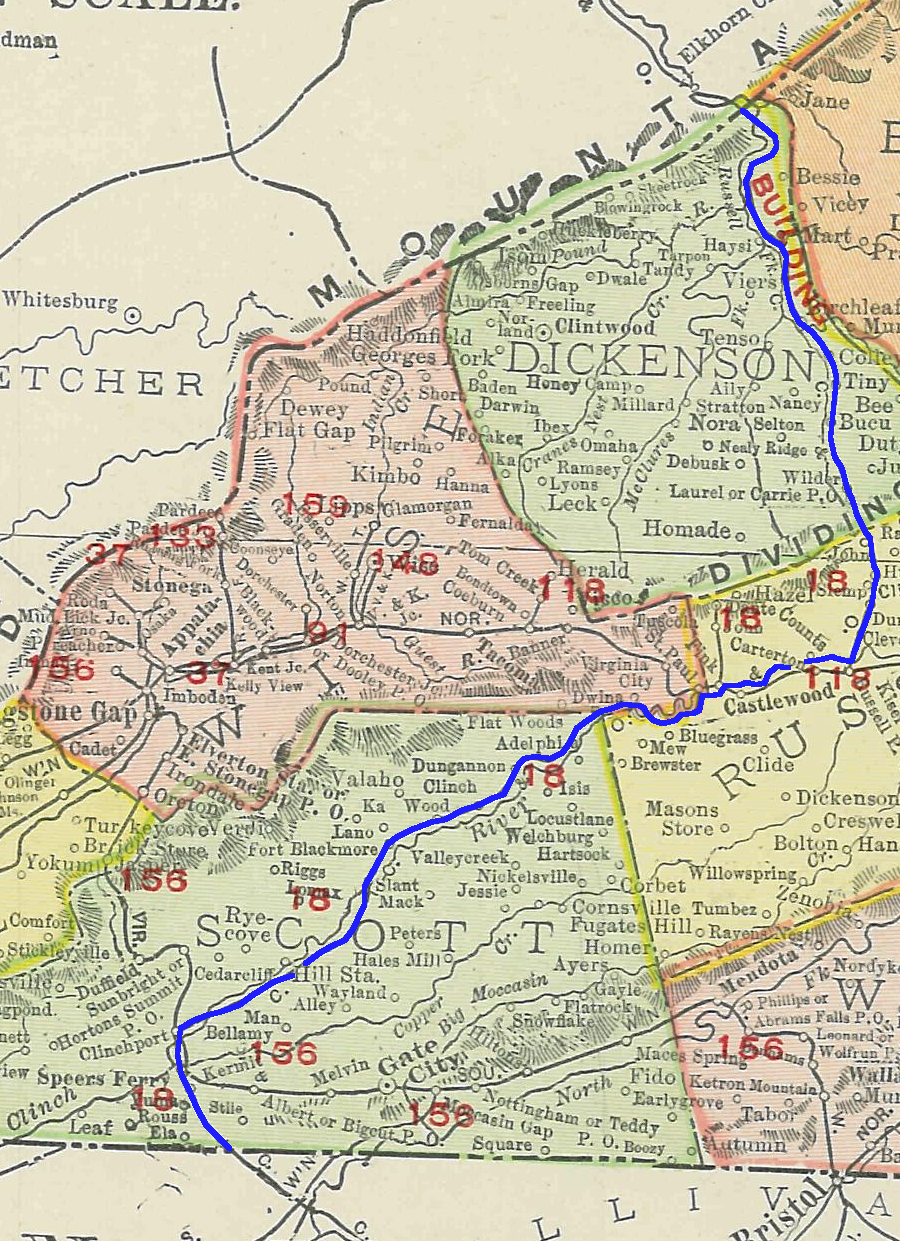
a 1913 map shows the extension of the CC&O (blue line) from Pound Gap to Elkhorn City as "Building"
Source: National Archives, The Library Atlas of the World; Volume 1: United States (1913)
Carter did not build north past Elkhorn City, Kentucky after 1915. He ended his railroad construction there, after making the connection to the Chesapeake and Ohio (C&O) Railroad. The two railroads battled to control the water-level route through Pine Mountain along the Russell Fork River, with rival survey and construction gangs.
After lengthy and expensive lawsuits, the two railroads settled. George Carter's Carolina, Clinchfield and Ohio Railway ended up building the track. It required four tunnels and two bridges, including State Line Tunnel at the Virginia-Kentucky border. The path through The Breaks was so narrow that no road for automobiles was ever built on the riverbank parallel to the railroad.
The northern terminus at Elkhorn City was 795 feet above sea level. The southern terminus at Spartanburg was 775 feet above sea level, only 20 feet lower in total elevation. However, to connect the two points required crossing the Allegheny Front at Sandy Ridge, Powell Mountain, Clinch Mountain, and the Blue Ridge.
The highest point on the railroad was at 2,628 feet. There were 10 miles of tunnels and over three miles of bridges. The longest stretch of straight track on the 277-mile route was just two miles, and 43% of the track was on a curve. There was little flat track on the railroad; trains were going up or down most of the time.
The 35-mile extension from Dante to Elkhorn City was the last part of the Clinchfield to be completed. Engineers surveyed 42 different routes. In contrast to other railroads such as the Chesapeake and Ohio that prioritized low initial construction costs through the mountains, Carter took the advice of his Chief Engineer M. J. Caples and focused on achieving long-term savings by minimizing curves and grades that force trains to go slow. The chosen route was one of the most expensive to build, but the quality of the engineering and construction made train operations on the railroad more profitable.
The railroad had built up the Clinch River to Dante by 1909. Over the next six years, it tunneled through Sandy Ridge and bridged its way down the McClure and Russell Fork rivers to Elkhorn City. The maximum grade on the entire line was 1.2%, and the tightest curve was only eight degrees.6
The 7,854-foot long Sandy Ridge Tunnel, the longest railroad tunnel ever constructed in Virginia, crossed the Eastern Continental Divide and got the railroad into the Mississippi River watershed. Trains passed under Sandy Ridge, entering the McClure River drainage in Dickenson County and accessing the mines at Trammel.7
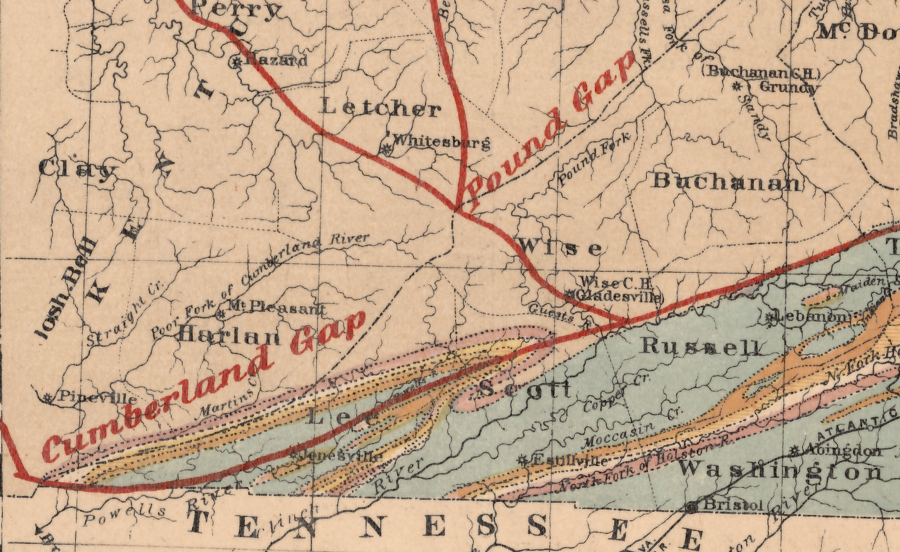
as early as 1875, Pound Gap was recognized as a preferred route for a railroad into Kentucky
Source: Map showing proposed routes of the Richmond and Southwest Railway (by Jedediah Hotchkiss, 1875)
After World War I, the Louisville & Nashville Railroad was originating traffic in the Virginia coal fields and transferring it to the Carolina, Clinchfield and Ohio Railway. Many of those loaded coal cars were hauled to Spartanburg, South Carolina and transferred to the Atlantic Coast Line, which delivered them to final customers and to Charleston for export.
To eliminate the costs for interchanging cars, the Louisville & Nashville and the Atlantic Coast Line leased the Carolina, Clinchfield and Ohio Railway in 1924. The railroad was known simply as the Clinchfield after 1924. In 1983, the corporate identity as an independent railroad disappeared when it was merged into the Seaboard System Railroad, which became part of CSX in 1986.8
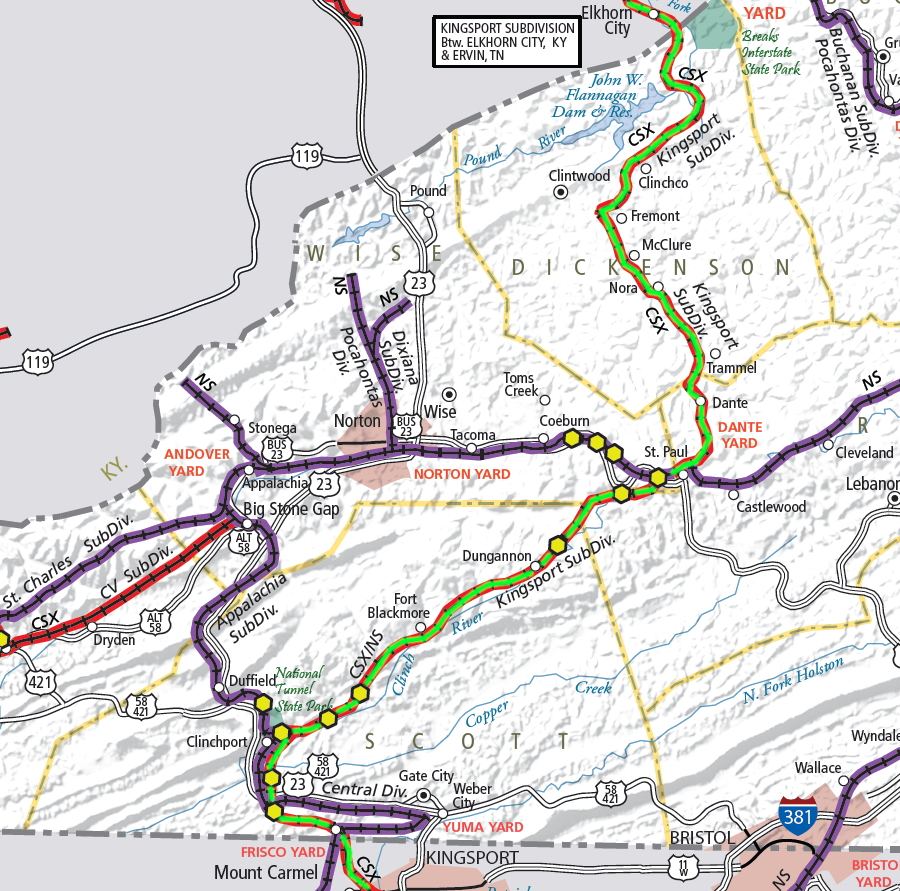
the route of the Clinchfield (green line) is still used by the CSX
Source: Virginia Department of Rail and Public Transit (DRPT), Virginia Rail Map (2019)
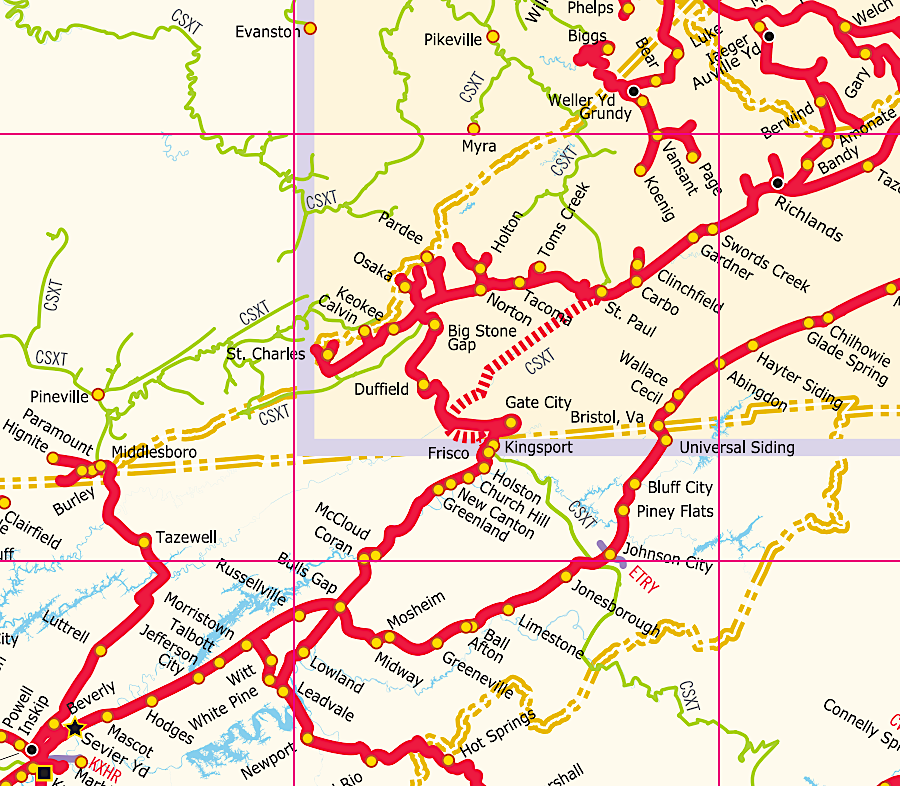
the Norfolk Southern has trackage rights over the old Clinchfield route between St. Paul-Frisco (red dashed line)
Source: Norfolk Southern, Norfolk Southern System Map (2016)
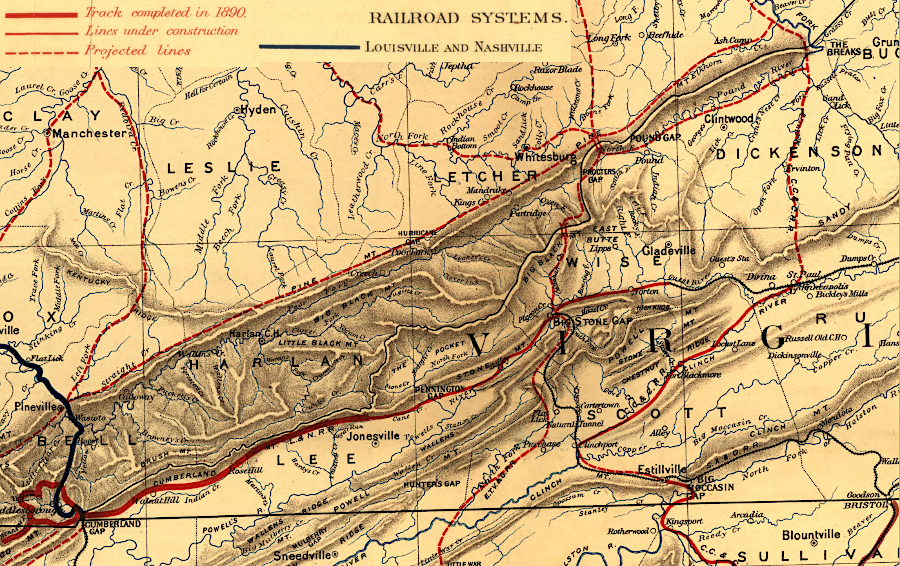
in 1891, the Louisville and Nashville Railroad anticipated building from Cumberland Gap to The Breaks
Source: Library of Congress, Preliminary map of Kentucky 1891